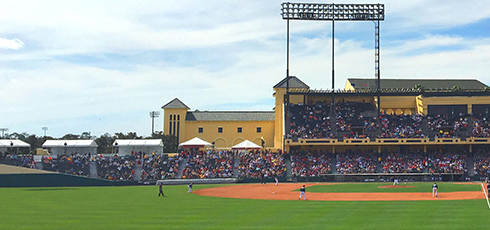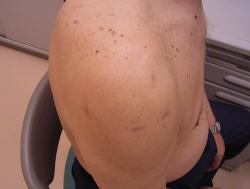
Rotator cuff repairment, Stabilization of shoulder instability
Our Shoulder Joint, Sports Injury, Knee Outpatient Clinic is available without appointment on Thursdays and Fridays. Generally, consultations are by appointment, but there are cases when appointment may not be necessary. Please call the Appointment Services Desk for inquiries on consultation.
Arthroscopic Surgery for Shoulder Joint Diseases
Sports Injuries and Arthroscopic Surgery
 Picture 1: Wound 2 weeks After Arthroscopic Surgery
Picture 1: Wound 2 weeks After Arthroscopic Surgery
Our hospital has worked and achieved results on therapeutic exercise for athletes with sports-related injuries, and treatment for joint diseases as well as walking ability improvements for the elderly. Arthroscopic surgery is minimally invasive and a leading role in rapid improvement for treatment results in joint lesions especially for sports injuries. Our department considers arthroscopic surgery for anterior cruciate ligament and meniscus injury as one of our specialties, but in recent years we have also actively incorporated minimally invasive operations using arthroscope for shoulder and elbow joint diseases.
Shoulder Joint and Arthroscopic Surgery
The shoulder joint has the largest range of movement in the human body and performs complex functions but it also is a joint supported by many muscles, ligaments and complex bone configurations. Symptoms of shoulder joint diseases include pain and functional disorder, and often display lesions deep down into many layers of skin and muscle. Existing methods raise great concern of invasion on normal tissues.
Arthroscopic surgery makes direct operations on lesions possible with minimal damage to normal tissues, less pain post-surgery and its future development has great expectations. This consultation requires proficiency in diagnosis as well as technique. Arthroscopic surgery at this point is a treatment method that is limited to state-of-the-art facilities.
Characteristic Diseases
1.Recurrent Dislocation of the Shoulder Joint
 Graph 2: Bankart Lesion
Graph 2: Bankart Lesion
Shoulder joint dislocations occur from sports injuries, and trigger minor injuries and dislocation/subluxation from daily life movements. This is caused by the rupture of the joint that stops the ligament in the shoulder or loose from the first dislocation. At times, it is accompanied by strain fracture of the joint margin.
 Graph 3: After Bankart Operation
Graph 3: After Bankart Operation
Recently, there is doubt on the effectiveness of long-term stabilization and rehabilitation such as strength training after injury for re-dislocation prevention. Instead, operational treatments are thought to be a more definite method to reacquire a braking effect. Athletes and teenagers who have been injured before have a higher risk of re-dislocation, and by repeating dislocations, there is a high possibility of injuring other normal tissues.
 Suture Anchor
Suture Anchor
The surgical methods are direct vision surgery (looking directly at the joint by opening the region) and arthroscopic surgery. The arthroscopic surgery has a low reluxation rate if conducted at a specialist facility, and it contributes to functional recovery speed and post-surgical pain relief. The latter uses special tools and strings (Suture Anchor) to fix broken ligaments or joint capsules. Depending on the patient the direct vision may be better, so we will decide the treatment course after consultation and examinations.
2.Cuff Tear
 Graph 4: Rotator Cuff Tear
Graph 4: Rotator Cuff Tear
The rotator cuff is the innermost muscle that supports the shoulder joint and is a tissue that has very important functions. The rupture of this cuff is referred as “Rotator Cuff Tear”. It may occur from external injuries or become ruptured from degeneration with age. In the latter case, it is generally considered as “subacromial bursitis” and may only be treated for pain relief. If symptoms do not improve after half a year, it is necessary to consult with a specialist.
 Graph 5: After Cuff Tear Operation
Graph 5: After Cuff Tear Operation
Symptoms include pain during movement, movement range limitation and pain during the night or when resting. The patient may feel discomfort, pain or listlessness when raising the arm. Some patients may not realize pain even with a rupture. However, recent studies have shown that conditions and size of the rupture progress over time. Operation treatment adaptation will be determined upon the age and social background of the patient, as well as symptoms, rehabilitation and drug therapy effects.
 Cuff Repairment Surgery
Cuff Repairment Surgery
Arthroscopic surgery has a big advantage because it can grasp details of the clinical condition through an arthroscope and can conduct operations without damaging the deltoid muscle, an important muscle on the surface of the rotator cuff. Using an arthroscope, our hospital conducts a two-line restoration method and a stratified restoration method, both considered ideal to reconstruct a strong cuff function. For 3 weeks post-operation, the patient must wear a gear to maintain shoulder joint in a resting position. After that period, specific rehabilitation is necessary.
3.Pitching Injuries Shoulder

Pitching injury is a condition where there is pain in the shoulder joint mainly from sports such as baseball, volleyball and tennis. It is thought to occur from muscle fatigue, periarticular tissue attrition and swelling. However, sometimes it is caused from glenoid labrum (a tissue that contributes to stability) and para-articular tendon injuries.
Treatment methods are determined after much examination of the cause of pain and conservative treatment through rehabilitation is prioritized. If conditions do not improve after this treatment method, arthroscopic surgery may be necessary. The arthroscopic surgery, which is minimally invasive for normal tissues, is used to either excise or repair (suture anchor technique) the injured area.
Shoulder arthroscopy may be suitable for other shoulder joint pains, functional disorders and subacromial bursitis. Please consult with your primary physician.
